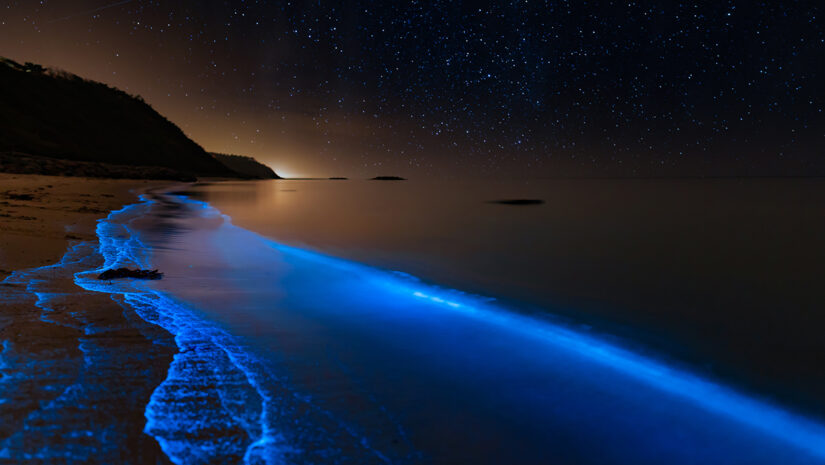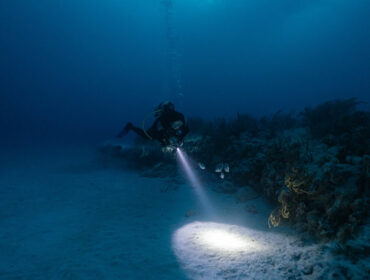Our planet offers breathtaking natural spectacles, both on land and beneath the waves. Few underwater phenomena rival the magic of bioluminescence, a natural light display produced by marine organisms. Bioluminescent plankton emits light when disturbed by movement, creating an otherworldly glow in the dark ocean. Bioluminescent diving should be on every diver’s bucket list. However, divers need specific skills and equipment to fully enjoy and safely navigate these unique conditions.
What Causes Bioluminescence?
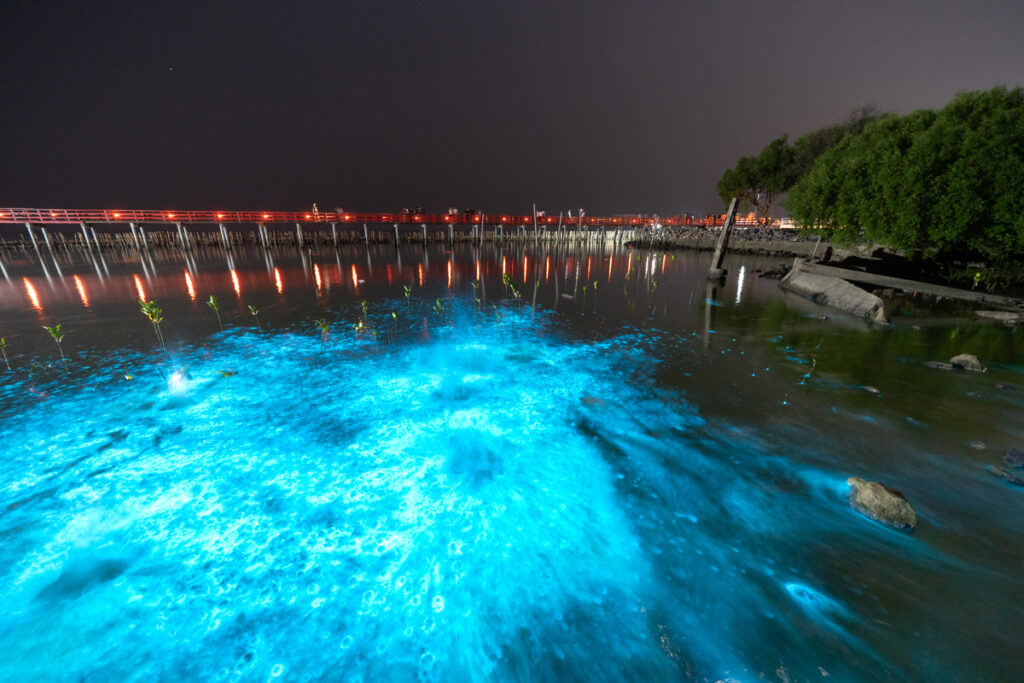
Bioluminescence is the ability of marine organisms to release light through a chemical reaction, often for survival purposes. This process occurs when a molecule called luciferin reacts with oxygen, sometimes aided by an enzyme called luciferase, producing a glow that illuminates the surrounding water.
Marine species use bioluminescence for different reasons. Plankton release light when disturbed by movement, creating the glowing trails often seen by divers at night. Deep-sea squid and certain fish produce bursts of light to confuse predators or communicate with their species. Some creatures, like anglerfish, use bioluminescence as a lure to attract prey in the dark abyss.
While many assume bioluminescence is rare, it is actually more common underwater than on land, with scientists estimating that up to 90% of deep-sea organisms have some form of bioluminescent ability. This natural phenomenon turns an ordinary night dive into a very special experience, making it one of the most unforgettable sights a diver can witness.
Best Places to Dive with Bioluminescence
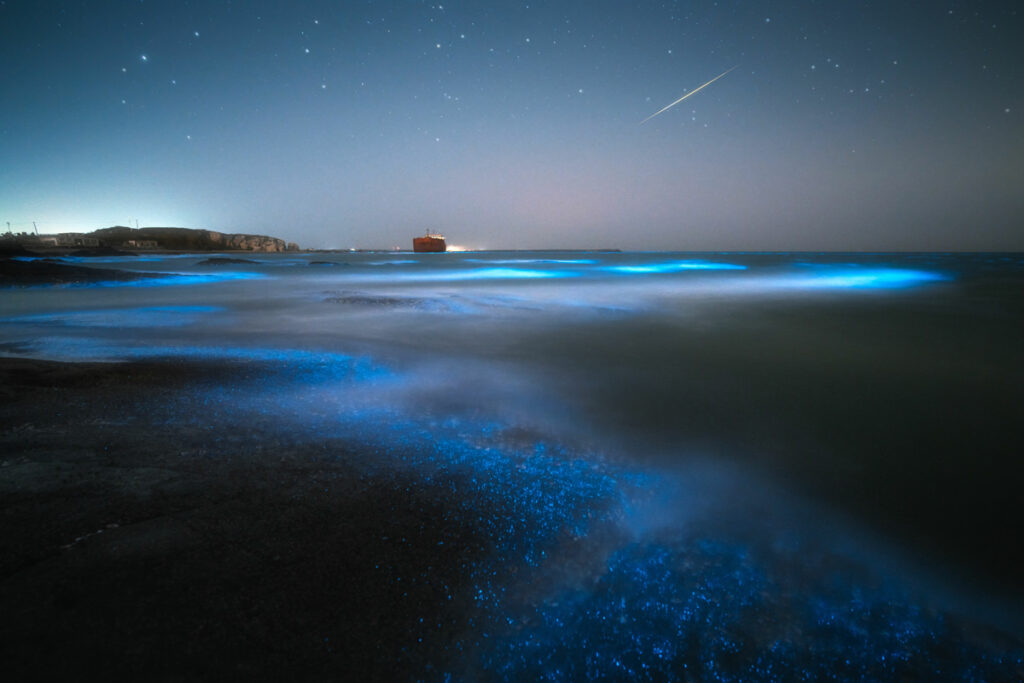
While bioluminescence can be found in oceans around the world, certain locations offer consistent and spectacular displays that make for unforgettable dives. The best bioluminescent dive sites typically have high concentrations of bioluminescent plankton, minimal light pollution, and calm waters that allow divers to fully immerse themselves in the glowing spectacle. If you’re not too sure where to start, check out the following locations.
1. Mosquito Bay, Puerto Rico
The bioluminescent plankton here emit an intense blue-green glow when disturbed, and it’s the warm, shallow waters that provide optimal conditions for snorkelers and divers. To have the highest chance of witnessing it in this bay, make sure you visit when the moon is hidden and the waters are at their darkest.
Puerto Rico’s Mosquito Bay is often considered the brightest bioluminescent bay in the world thanks to its high concentration of dinoflagellates, the microscopic plankton responsible for the glowing effect. Divers and snorkelers who move gently through the water can create luminous trails, making it one of the most mesmerizing places to experience bioluminescence.
2. Toyama Bay, Japan
Unlike plankton-based bioluminescence, Toyama Bay is famous for firefly squid, which use bioluminescence for communication and camouflage. During their migration, thousands of these tiny squid rise from the depths and light up the water in a surreal, electric-blue glow. They produce pulsing blue lights during the spawning season, and it’s the shallow waters from March – June that offer the best conditions to see this. While diving is restricted in some areas, guided night tours offer a chance to see this rare spectacle.
3. Anilao, Philippines
Anilao is a hotspot for underwater photographers, thanks to its rich biodiversity and glowing marine species. This biodiversity continues to put on a show throughout the night. Divers may encounter bioluminescent jellies, shrimp, and cuttlefish, each displaying their unique light patterns. Night dives in these waters often feel otherworldly, with flashes of blue and green appearing unexpectedly in the dark. If you’re a fan of muck diving, this is the place for you, day and night. Visiting Anilao from December to May will ensure you have the best visibility to witness the diversity of the phenomenon.
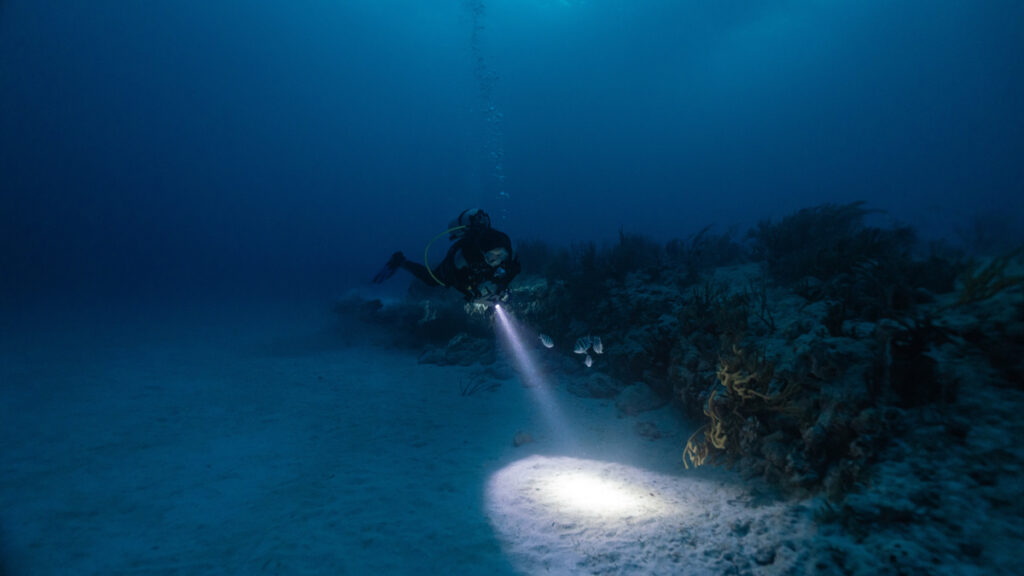
How to Prepare for a Bioluminescent Night Dive
Diving in the dark requires preparation, the right equipment, and specific skills to ensure safety and enjoyment. Whether you’re a seasoned night diver or experiencing it for the first time, proper planning, just like you would for any other dive, makes all the difference.
Complete Your Night Diver Specialty Course
Nothing can replace training with a professional, and a night diver course can equip you with the necessary understanding of the additional risks that diving at night can introduce. This environment brings new challenges and, therefore, new risks that you may not be used to.
From limited visibility, depth perception difficulties, and different methods of communication, most dive certification agencies offer Night Diver Specialties that train divers in essential skills like torch use, buddy awareness, and emergency procedures. If you’re unfamiliar with night diving, it’s best to gain experience in standard night dives before attempting a bioluminescent dive.
Choose the Right Dive Equipment
Diving at night requires reliable, high-quality gear to navigate safely. A primary dive torch is essential, but for a bioluminescent dive, using a red-light torch instead of white light helps preserve night vision and allows bioluminescence to stand out more. A backup torch is crucial in case of equipment failure, and a dive computer with a glow-in-the-dark or backlit display makes it easier to monitor depth and bottom time in the dark.
Exposure protection is another key consideration—bioluminescent plankton thrive in warm and cold waters, so choosing the right wetsuit or drysuit for the conditions ensures comfort throughout the dive.
Plan the Dive with an Experienced Guide
Because bioluminescence occurs in specific conditions, diving with an experienced guide improves your chances of seeing a spectacular display. Dive guides know the best times and locations, taking into account factors like plankton density, tidal movements, and water clarity. Your dive plan should factor in tides, currents, and moon phases.
The moon phases play an important role. Darker nights, especially during new moons, provide the best visibility for glowing plankton. Additionally, because night dives make navigation more challenging, diving with a buddy system and following a clear dive plan will ensure everyone’s safety.
Understand the Local Marine Life and Conditions
Before diving, it’s important to research the area’s marine life and environmental conditions. Arrive prepared for your dive briefing, do your own background reading, and don’t rely on your guide to tell you everything. Some bioluminescent species, such as certain fish and jellies, use light as a defense mechanism, which means excessive disturbance could alter their natural behavior.
Some bioluminescent bays and coastal areas are protected, and diving might be restricted to avoid disrupting delicate ecosystems. Checking local regulations ensures a responsible and ethical dive experience.
What to Expect During a Bioluminescent Dive
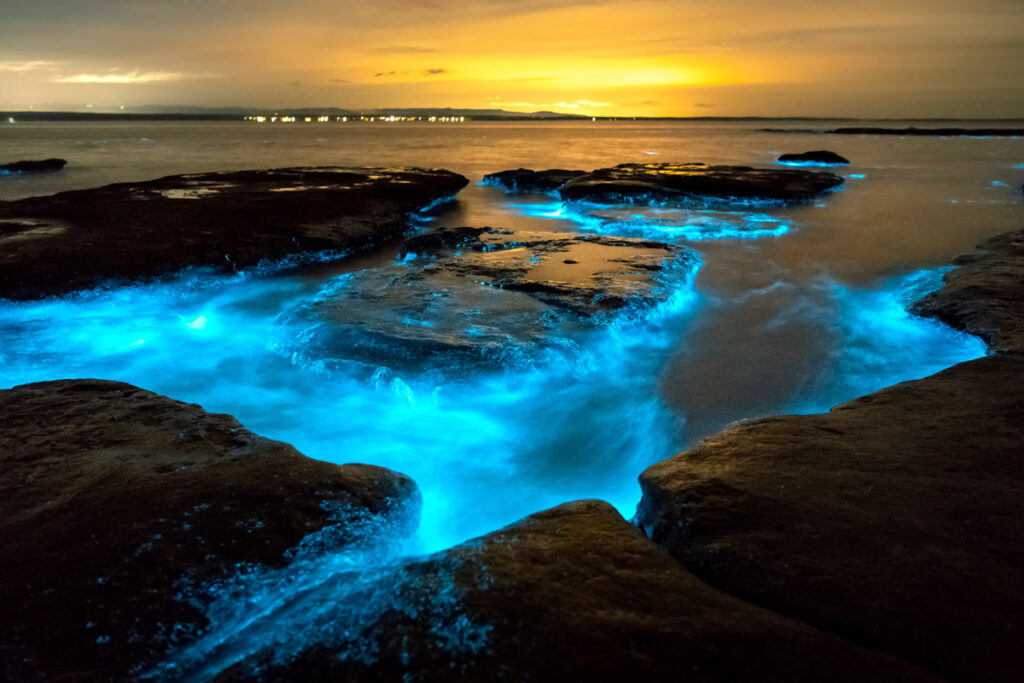
Unlike daytime dives, where marine life and landscapes are clearly visible, a bioluminescent night dive is about embracing the unknown and using your senses differently. Understanding what to expect will help divers make the most of this unique experience.
Minimal Light for Maximum Glow
To fully appreciate bioluminescence, less light is better. Dive guides often recommend turning off dive torches at key moments, allowing complete darkness to amplify the glowing plankton around you. The best conditions for a bioluminescent dive occur on moonless nights, where the lack of natural and artificial light pollution enhances visibility. Divers should also avoid areas with coastal light pollution, as it can diminish the glowing effect.
Slow and Controlled Movements
Unlike regular dives, where movement is often intentional and directional, bioluminescent diving rewards slow, deliberate actions. Waving your hands gently through the water can create swirling trails of blue-green light, and even something as simple as exhaling bubbles can trigger a soft glow as the plankton reacts to the disturbance. Remember, kicking too forcefully can stir up sediment. Thus reducing visibility and dulling the effect of bioluminescence. Be slow and gentle.
A Different Perception of Depth and Space
Because most of what you see is glowing movement, bioluminescent diving feels very different from traditional night diving. Without visual references like coral, wrecks, or rock formations, depth perception can soon become distorted, making it important to monitor your depth gauge and dive computer frequently.
Many divers describe the experience as floating in a starry sky, as the glowing particles resemble distant galaxies. This unique sensation of weightlessness and light play is part of what makes bioluminescent dives so magical.
Safety Considerations for Bioluminescent Night Diving
Diving at night presents unique challenges, and when combined with the allure of bioluminescence, it’s easy to become distracted. Divers must be extra cautious to ensure a safe and enjoyable experience. Proper preparation, communication, and awareness of potential risks will help you navigate the darkness with confidence.
Maintain Close Buddy Contact
Staying close to your dive buddy is critical, as visibility is limited, and it’s easier to become disoriented or separated. Before the dive, agree on hand signals or light signals to communicate underwater. Using a torch to signal your buddy with slow, deliberate movements can help maintain contact without disrupting the bioluminescent experience.
Monitor Depth and Time Correctly
In low-light environments, divers can easily lose track of their depth. Since there are fewer visual reference points, it’s essential to monitor your dive computer regularly. Slow, controlled ascents and constant depth awareness help prevent decompression issues and unintentional overexertion.
Carry a Back-up Light
While bioluminescence is best viewed in darkness divers should always carry a backup light in case of primary torch failure. Many night divers attach small glow sticks or LED tank lights to their gear to increase visibility without disrupting the experience. Checking batteries and ensuring all lights function properly before entering the water is a simple but vital safety step.
Be Aware of Marine Life Behavior at Night
Many marine creatures behave differently after sunset. Some species, like bioluminescent plankton, glow when disturbed, while others, such as certain fish and jellies, use light for defense. Additionally, predatory species like moray eels, octopuses, and barracudas become more active at night, meaning divers should be cautious about unintended encounters. To respect the marine environment, avoid shining bright lights directly at wildlife, and refrain from excessive movement that could startle creatures in their nighttime habitat.
Stay Calm and Oriented
If you feel lost or unsure of your position, staying calm and stopping movement can help you regain spatial awareness. Many divers find that fixing their gaze on bioluminescent trails or bubbles provides a sense of direction. Before attempting a bioluminescent dive, it’s recommended to dive at the same site during daylight to familiarize yourself with the surroundings.
Is it Safe to Swim in Bioluminescence?
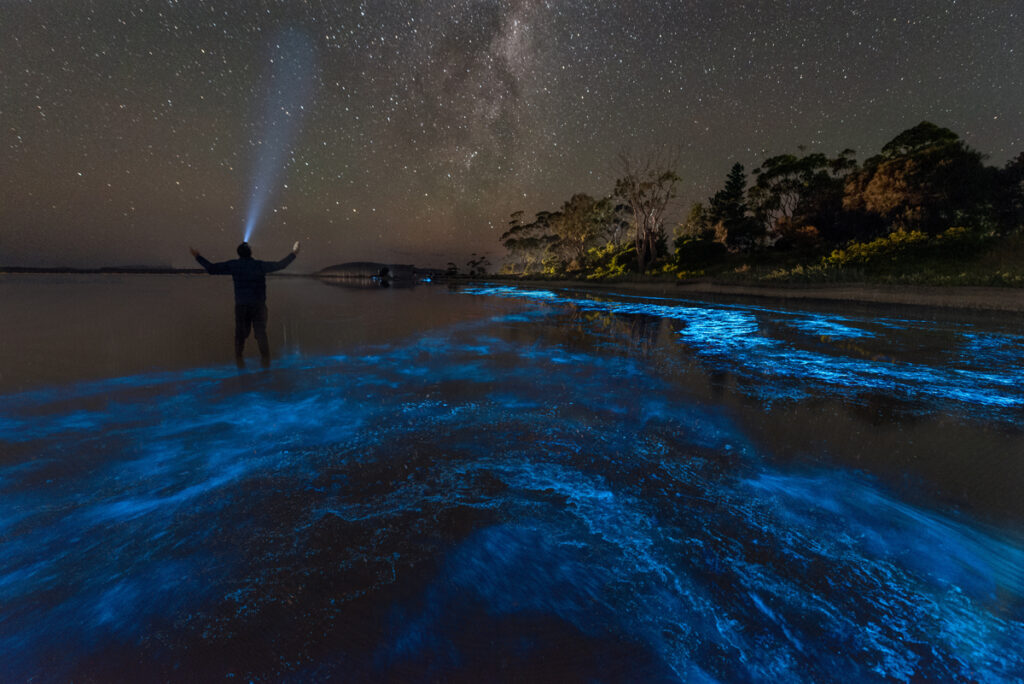
Diving in bioluminescence is generally safe, provided divers follow standard night diving protocols and prepare accordingly. The primary risks associated with bioluminescent dives stem from low visibility, depth perception challenges, and limited navigation cues rather than the bioluminescence itself. Since many glowing marine organisms are microscopic plankton, they pose no direct threat to divers.
However, some larger bioluminescent species, like jellyfish and certain fish, use their light as a defense mechanism, meaning divers should observe without excessive disturbance. As with any night dive, proper training, equipment checks, and buddy communication are essential to ensure safety in the dark. By planning the dive carefully and remaining aware of their surroundings, divers can safely enjoy the ethereal experience of glowing waters.
What is the Difference Between Bioluminescence and Biofluorescence?
Bioluminescent organisms emit light through a chemical reaction, whereas biofluorescent organisms absorb light at one wavelength and re-emit it at another, usually longer wavelength.
Understanding the difference between bioluminescence and biofluorescence is key to appreciating the diverse light phenomena in the ocean. These processes may seem similar but occur through distinct mechanisms.
In bioluminescence, the light is generated internally, while in biofluorescence, the organism acts like a natural filter that transforms ambient light. Both phenomena offer unique visual displays and can be seen during night dives; however, bioluminescence occurs spontaneously as part of a chemical process, whereas biofluorescence requires an external light source—usually blue light—to become visible. This key distinction shapes how divers experience and photograph these natural events.

